Found a total of 10000 related content

Top 15 jQuery Forms Examples
Article Introduction:jQuery empowers form design: improve user experience and visual effects
jQuery simplifies form design, allowing you to easily achieve various graphic designs and interactive effects. Some jQuery plug-ins can enlarge text boxes to make them more eye-catching; some plug-ins provide ready-made form templates, including basic elements such as text boxes, radio buttons, and check boxes. Related readings: 30 jQuery form plugins
iPhone Style Checkbox
Check boxes that mimic the famous switch style of iPhone. Source: http://awardwinningfjords.com/2009/06/16/iphone-style-checkboxe
2025-03-07
comment 0
728
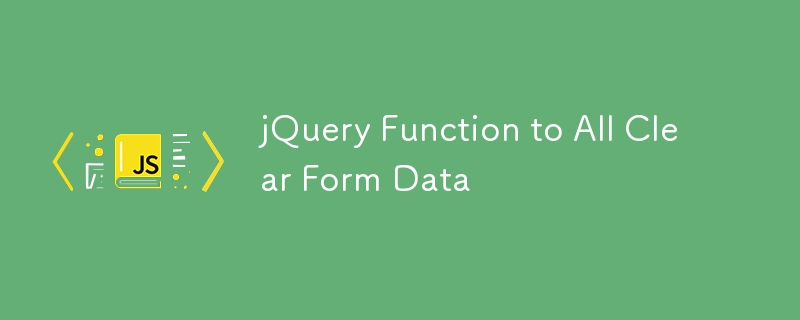
jQuery Function to All Clear Form Data
Article Introduction:This article describes several practical ways to use jQuery to clear form data from Karl Swedberg's website. These methods can clear all data in the form, including text input boxes, drop-down lists, radio buttons, check boxes, etc.
Method 1: General Function
The following function iterates through all input elements in the form and clears their data according to the element type:
function clearForm(form) {
$(':input', form).each(function() {
var type = this.type;
var tag = this.tag
2025-03-02
comment 0
694

What are the essential elements for building forms in html?
Article Introduction:To create a fully functional HTML form, it must include the following core elements and steps: 1. Use tags as form containers and set properties such as action, method, enctype; 2. Add input controls such as text boxes, password boxes, submission buttons, radio buttons, check boxes and drop-down selection boxes; 3. Set name attributes for each control so that the server can identify data; 4. Use tags to improve usability and enhance interaction efficiency; 5. Use placeholder, required, aria-label and other properties to optimize user experience; 6. Consider mobile adaptation, use appropriate inputtype and combine it with front-end verification mechanism; 7. Provide clear error prompt information, and ensure that
2025-07-04
comment 0
819

What are the different types of input fields (text, password, email, number, date, checkbox, radio, file, submit, reset)?
Article Introduction:Common input fields for web forms include text, password, email, number, date, radio boxes, check boxes, file upload, submit buttons and reset buttons. 1. Text input (text) is used to freely enter text content, requiring additional verification; 2. Password input (password) hides user input and is often used with confirmation of passwords; 3. Email input (email) automatically checks the format, mobile adaptation optimization; 4. Number input (number) limits input to numbers and supports setting range and step size; 5. Date selection (date) provides calendar controls to improve experience, but compatibility needs to be considered; 6. Radio box (radio) is used for multi-option radio, and the name attribute must be consistent; 7. Checkbox (checkbox) is used for multiple
2025-06-26
comment 0
895
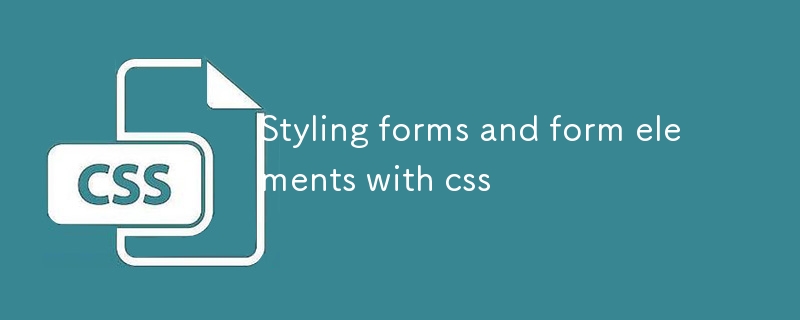
Styling forms and form elements with css
Article Introduction:To make the form more beautiful and improve the user experience, you can optimize it from the following four points: 1. Unify the basic style of the input box and add: focus effect; 2. Hide native check boxes and radio buttons and replace them with custom icons; 3. Set hover, active status and animation for the submission button; 4. Keep the form layout neatly and aligned, and use .form-group to uniform spacing.
2025-07-10
comment 0
562

Setting Default Values for Form Inputs with the HTML value Attribute
Article Introduction:The most direct way to set the default value of the form input box is to use the HTML value attribute. The value attribute is used to specify the initial value of the form element, such as:. Common elements that support this attribute include text input boxes, password boxes, radio buttons, check boxes (need to be selected by default with checked settings), submit buttons, etc. Correct usage methods include setting strings for text input, setting legal values for numeric input, and transmitting hidden fields. Notes include: avoid unescaped special characters and elements with selected instead of value, and default values should be written in the tag content. Rational use of value can improve user experience and reduce input burden.
2025-07-13
comment 0
444
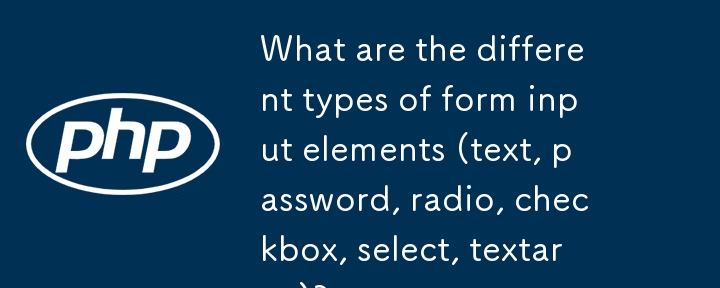
What are the different types of form input elements (text, password, radio, checkbox, select, textarea)?
Article Introduction:When building a web form, you should select the appropriate input element according to the required data type. 1. Text input is used for short text such as name or email, and is used with placeholders, maximum character restrictions and labels; 2. Password field hides user input, requires pairing verification and prompts for requirements; 3. Radio buttons are used to select one of multiple options, and share name attributes; 4. Check boxes allow multiple selections, suitable for boolean values ??or function selection; 5. The drop-down menu saves space and is suitable for known option lists; 6. Multi-line text boxes are used for long content input, supporting line breaks. Rationally combining these elements can improve form functionality and user experience.
2025-06-26
comment 0
787

Formdata in JavaScript: definitive guide to handle forms
Article Introduction:The FormData object of JavaScript provides a convenient way to process the HTML form data, especially when using Ajax or fetch to send data to the server. The New FormData () constructor creates a new FormData instance.
You can pass the HTML table element directly as the parameter to New FormData (). The constructor will automatically collect all input field data in the form, including text boxes, check boxes, radio buttons, and file upload fields, and add them to the FormData object.
Use the advantage of FormData
FormData
2025-01-25
comment 0
876

Why is using the html label tag with form inputs important?
Article Introduction:Using the <label> tag can significantly improve the usability and accessibility of forms. First, it provides screen reader users with a clear input context, ensuring correct association through the for attribute matching to id; second, it expands the click area of ??check boxes and radio buttons, improving the convenience of mobile operations; finally, clear labels help form verification prompts and overall ease of use, and keep the label concise, avoid relying solely on placeholder text, and use ARIA attributes with caution.
2025-07-05
comment 0
157
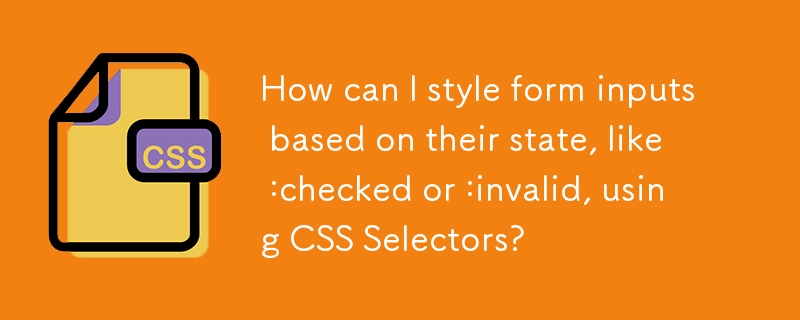
How can I style form inputs based on their state, like :checked or :invalid, using CSS Selectors?
Article Introduction:To style the different states of form input (such as selected, invalid or focused), the CSS pseudo-class should be used. 1. Use the checked pseudo-class to set styles for selected check boxes or radio buttons; 2. Use the:invalid pseudo-class to set styles for fields that have not passed the verification, combined with: user-invalid can be applied after user interaction; 3. Use the:focus and:hover pseudo-classes to enhance availability and accessibility; 4. Multiple pseudo-classes can be combined to implement multi-state style design, such as matching invalid and focused states at the same time. These methods can achieve dynamic style changes without JavaScript.
2025-07-01
comment 0
808

How do I use the name attribute to give an input field a name that will be used when submitting the form?
Article Introduction:Use the name attribute to define the field name when the form is submitted, and the server identifies the data type by this name. For example, name="email" will send user input as an email address. Correct usage methods include: 1. Use meaningful names such as username; 2. Avoid using spaces and special characters with first_name; 3. Keep the names of multiple forms consistent; 4. Share the names of related check boxes and add square brackets such as interests[]. Different input types handle differently. Radio buttons need to share names to ensure mutually exclusive selection. Different names should be used if the check box is independent. Common errors include missing name attributes, unrelated fields duplicate names, mismatch of front and back end names, etc., which may cause data to be located.
2025-06-30
comment 0
925
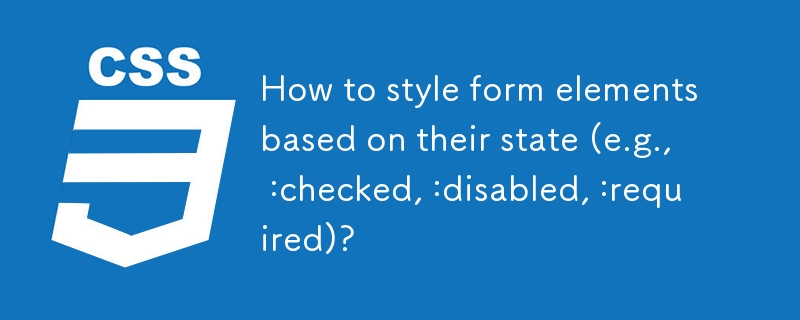
How to style form elements based on their state (e.g., :checked, :disabled, :required)?
Article Introduction:The state style of form elements can significantly improve the user experience, and through visual feedback, users can clearly understand the option status, required items and disable effects. 1. Use: checked pseudo-class to highlight the selected items, and personalize check boxes or radio buttons by hiding native controls and customizing styles; 2. Use: disabled pseudo-class to make the disabled state more intuitive. Common methods include reducing transparency, changing background color and setting the non-clickable cursor; 3. Use: required pseudo-class to identify required items, usually combining border color and red asterisk prompts, and it is recommended to enhance accessibility with text or icons; 4. Pay attention to the casing order when multiple states coexist. It is recommended to follow the default, hover, focus, active, and disabled.
2025-07-14
comment 0
735

How to handle forms in Vue
Article Introduction:There are three key points to be mastered when processing Vue forms: 1. Use v-model to achieve two-way binding and synchronize form data; 2. Implement verification logic to ensure input compliance; 3. Control the submission behavior and process requests and status feedback. In Vue, form elements such as input boxes, check boxes, etc. can be bound to data attributes through v-model, such as automatically synchronizing user input; for multiple selection scenarios of check boxes, the binding field should be initialized into an array to correctly store multiple selected values. Form verification can be implemented through custom functions or third-party libraries. Common practices include checking whether the field is empty, using a regular verification format, and displaying prompt information when errors are wrong; for example, writing a validateForm method to return the error message object of each field. You should use it when submitting
2025-07-04
comment 0
519

How to associate a with an input field for better accessibility?
Article Introduction:The core method for correctly associating and input boxes is to use the for attribute matching ids to ensure that the screen reader accurately recognizes and improves the accessibility experience. 1. When using the for and id attributes, the values ??must be exactly the same; 2. You can wrap them directly, but problems are prone to occur when the structure is complex; 3. Check boxes and radio buttons should also be added to enhance click areas and accessibility; 4. It is not recommended to rely solely on aria-label or aria-labeledby instead of native tag association methods.
2025-06-27
comment 0
530

How to create a form in HTML
Article Introduction:To create a form with a good user experience in HTML, you need to pay attention to the following key points: 1. Use tags to define the form structure and set action and method attributes; 2. Add common input fields such as text boxes, password boxes, radio buttons, etc.; 3. Improve user experience through label tags, required attributes, and appropriate input types; 4. After submission, the data must be processed by the backend, and tools can be used to simulate it during testing. The infrastructure of the form is wrapped by a tag, and the commonly used method is POST to ensure security; each input field should be paired with label and set the correct name and id attributes; details include required verification, mobile keyboard adaptation and data format verification; processing after submission is based on
2025-07-05
comment 0
338

What are the different input types in an HTML form
Article Introduction:There are 8 common input types in HTML forms, which are suitable for different data input requirements. 1.text is used for basic text input; 2.password is used to hide the password input displayed; 3.email is used to input email addresses specifically; 4.number is used for digital input and supports adjustment of numerical values; 5.checkbox is used for multiple selection check boxes; 6.radio is used for single-select button groups; 7.date provides date selection function; 8.submit is used to submit form data. Each type has its own specific uses and browser support features. Regular use can improve user experience and data processing efficiency.
2025-07-07
comment 0
940

How do I use the and elements to group related form elements?
Article Introduction:and for improving form accessibility and structural clarity. 1. Used to group relevant form controls, and add border wrapping elements by default; 2. As the title of the group, it provides semantic labels and assists the screen reader to understand the structure; 3. It is often suitable for related input items such as multi-select buttons and check boxes, such as gender selection, payment methods or survey questions; 4. It must be placed in the header when used, and ensure that each input item is included to enhance usability; 5. The style can be customized through CSS, but it should be avoided to affect visual hierarchy and accessibility. Rational use and make the form easier to understand and more structured.
2025-06-19
comment 0
392

How do I use the element to create a submit button that submits the form?
Article Introduction:To create a submit button, it is recommended to use or. 1. Use the tag and set type="submit", which is the preferred method because it supports more content and style customization, such as SubmitForm; 2. The alternative is to use it, which is suitable for simple forms, but does not support complex content; 3. Make sure the button is inside the tag, otherwise the data cannot be submitted, and check whether the action and method properties are correct. Additionally, there can be multiple buttons in a form, but by default only one should be a submit button.
2025-06-21
comment 0
575

Designing and Validating HTML Forms for User Input
Article Introduction:Designing and verifying HTML forms requires both user experience and data accuracy. 1. Use appropriate form elements to improve the interactive experience and assist the browser to identify the input type, such as inputtext for text, inputpassword for password, radio for single choice, checkbox for multiple choice, and select for pull-down option; 2. Use HTML5 built-in verification function to reduce JavaScript workload, including required attribute, type=email/url automatic format verification, and min/max/pattern restriction input; 3. Back-end verification cannot be omitted, and it is necessary to check whether the field is empty, verification format, filter sensitive content, and limit input length
2025-07-16
comment 0
140


















